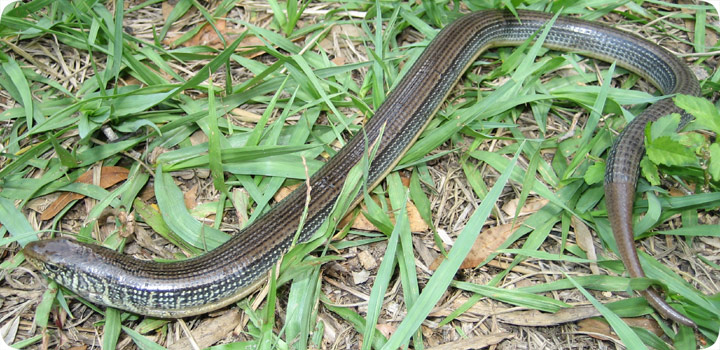-
info@aaanimalcontrol.com
Call us for help in your town
Humane Wildlife Education
Eastern Glass Lizard

05.30.2007 - This is an Eastern Glass Lizard, (Ophisaurus ventralis), often referred to as a Glass Snake. It is actually a lizard, but it looks of course, like a snake. It lives mostly in the SE United States, and throughout Florida. They grown up to about 30 inches long, and they eat mostly insects. They spend much of their time underground, and that's where I caught this one. I was at a customer's house, sealing some holes near the base of the house, and I saw a little bit of this lizard, and it went under the dirt, and I scrounged it up. I think it is pretty.
This reptile got its name because of its tail. As with many lizards, if it's attacked and a predator has it by the tail, it can detach the tail, allowing the rest of the animal to escape and survive. The tail of the Glass Lizard apparently will break into many pieces,
like glass. The pieces will also move, so that the predator will focus on them, and allow the body of the animal to get away. When I caught my first Glass Lizard and informed my former roommate of this, he said, "Oh we have GOT to see this!" and he wanted to tear the
tail off, but I refused, since I'd rather not mutilate animals for my own amusement. Sure, the snake would survive, but be at a significant disadvantage, and have to spend all of its resources on growing a new tail. And that's with no guarantee that we'd actually get
to witness our shattered writhing piece of tail show. My roommate later satisfied his desire to see a shaking tail show at the Booby Trap (now called Club Harem) on Fairbanks Ave.
Do it yourself: Visit my How To Get Rid of Snakes page for tips and advice.
Do it yourself: Visit my How To Get Rid of Lizards page for tips and advice.
Get professional help: Visit my Nationwide Pro Directory of wildlife removal experts.
For more wildlife stories, click my Wildlife Blog
or click my below banner to hire a local trapper.
Eastern glass lizards (Ophisaurus ventralis) are long, skinny, legless lizards that many people mistake for snakes upon their first glance. Generally an adult eastern glass lizard is between 18-24 inches long (46-108 cm). Eastern glass lizards diverge from being classified as snakes because of their mobile eyelids, inflexible jaw, and ear openings. The eastern glass lizard is commonly found throughout the southeastern United States, especially in Florida. To differentiate the eastern glass lizard with other glass lizards, look for dark markings around its head. If the lizard doesn't have any markings then it's likely not an eastern glass lizard but it may be another subspecies.
Are Glass Lizards Dangerous?
Although glass lizards resemble snakes, they don't bring nearly the same amount of danger. No species of glass lizards are poisonous. Glass lizards will rarely attempt to bite you. When they do bite, you might not even notice it: an eastern glass lizard's bite won't even bruise let alone break human skin. Glass lizards eat a variety of insects, spiders, and some small reptiles. Glass lizards don't even present a danger to your pets!
Eastern Glass Lizard Habits and Habitat
Eastern glass lizards tend to live in humid areas with water near it like a swamp, wetlands, or on a sandy beach. Eastern glass lizards can be found throughout the southeastern United States with the most frequent sightings in Florida but you can expect to find them as far north as Georgia or South Carolina.
Eastern glass lizards are nocturnal and prefer hunting at night. During the day, you'll see eastern glass lizards relaxing or sleeping in a shady, covered area. At night you might see them slithering around, looking for their prey. If a female has eggs in her nest, the female will stay at the nest until the eggs hatch unless the nest gets uncovered. If the nest gets uncovered and becomes exposed to the sunlight, the female will abandon her eggs and move on. Glass lizards are named as such because when they're startled or picked up, the glass lizard will break off its tail (about half of its body) to confuse the predator and give the glass lizard time to escape. The lizard's tail will eventually grow back but never to the length it once was. This means that the lizard's length generally correlates with its age and how many predator attacks it has survived.
What Should I do if a Glass Lizard is in my Backyard?
If a glass lizard is in your backyard it's recommended that you leave it alone. They won't hurt anyone or do any damage to your property. First, confirm it's not a snake that could seriously hurt you or someone that visits your house. Then, check if there are eggs, they will probably be under your deck (definitely out of the sun). If there are eggs, just leave the nest alone, the lizards will leave within 60 days. If there aren't eggs you can simply reveal the shady area to the sun and the lizards will leave.




















